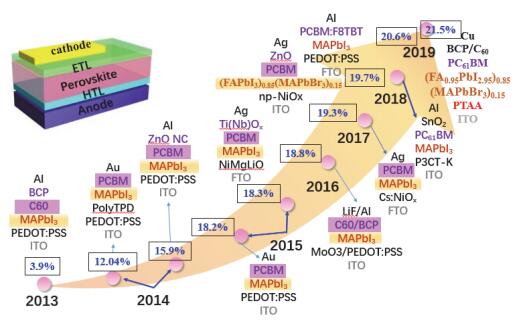摘要/Abstract

反式结构的钙钛矿太阳能电池由于其稳定性好、迟滞效应低等优点越来越受到人们的关注. 自2013年出现以来, 其光电转换效率从最初3.9%快速提升至21.5%. 然而, 反式钙钛矿太阳能电池的光电转化效率相比于传统正置结构钙钛矿太阳能电池依然存在差距, 同时其柔性及空气稳定性和大面积制备技术的开发仍是当前急需亟待解决的难题. 本文就反式钙钛矿太阳能电池载流子传输材料的选择、界面优化及柔性器件的发展等方面进行了系统的综述, 试图总结由结构和材料优化实现反式钙钛矿太阳能电池的高效率、高稳定性、大面积及柔性制备的普遍规律.
关键词: 反式钙钛矿太阳能电池, 工作机理, 载流子传输材料, 界面优化, 柔性器件
Since the introduction of perovskite solar cells in 2009, perovskite solar cells have developed rapidly due to their low-cost and high theoretical photoelectric conversion efficiency. Among them, the inverted structure of perovskite solar cells has received more and more attention due to its good stability and low hysteresis effect. Since its inception in 2013, its photoelectric conversion efficiency has rapidly increased from the initial 3.9% to 21.5%. However, compared with the traditional upright structure perovskite solar cells, there is still a gap in the photoelectric conversion efficiency of inverted perovskite solar cells. Due to the nature of the organic materials used, perovskites are more severely affected by moisture in the air environment. They are heavily dependent on nitrogen protection during device manufacturing. In the future, if perovskite solar cells are put into production, the fully enclosed waterless environment will obviously increase the production costs. At the same time, the development of large-area preparation technology is still a difficult problem to be solved. The development of inverted perovskite solar cells, the selection of carrier transport materials, interface optimization, and the development of flexible devices are systematically reviewed in this paper. For example, PEDOT:PSS was doped by GeO2 and DMSO, and PEDOT:PSS was modified by MoO3 and GO to improve its work function, acidity and hygroscopicity. A NiOx dense layer is usually doped with Mg 2+, Li + and Cs 4+ to increase its conductivity, which can be prepared by different methods such as magnetron sputtering and sol-gel method. The PCBM interface is modified by C60, BCP, LiF etc., to enhance its ohmic contact with the metal counter electrode. And the PCBM is doped by graphene, CoSe, SnO2 etc., to reduce the charge recombination caused by the interfacial resistance and the defects of the perovskite film. This paper would provide a way to obtain a high efficiency inverted perovskite solar cells by structure and material optimization. And it also give insights into the general rules for preparing large area and flexible devices.
Key words: inverted perovskite solar cell, working mechanism, carrier transport material, interface optimization, flexible device
PDF全文下载地址:
点我下载PDF
